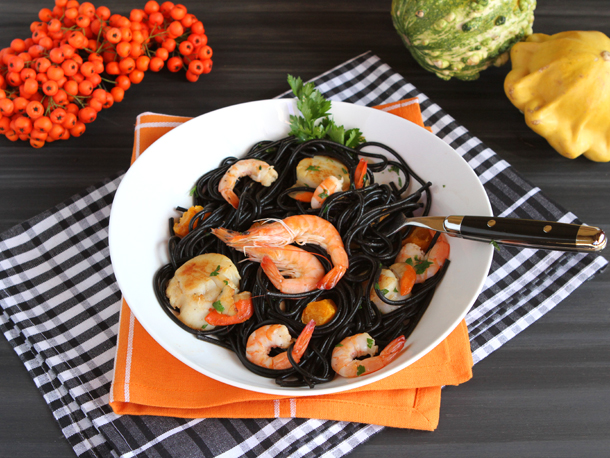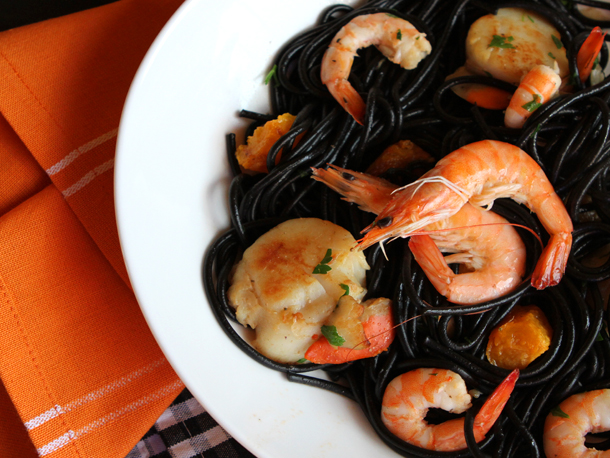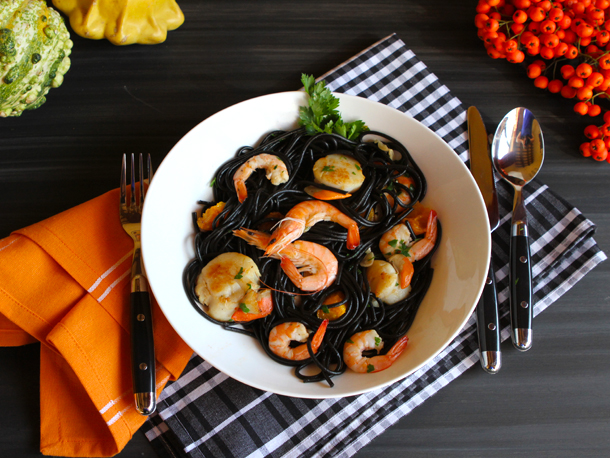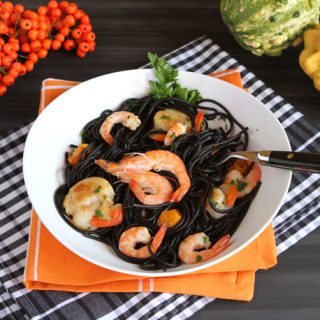Squid Ink Pasta With Shrimp and Scallops

Who says Halloween is just for kids? Many adults also like to join in the fun by dressing up, throwing theme parties, and preparing holiday foods. Although celebrating Halloween in Italy isn’t as widespread as it is in North America, each year sees more and more holiday decorations, scary jack-o-lanterns, and even children’s costumes being sold across the region. Italian children don’t trick-or-treat, but many schools and communities are now throwing Halloween-themed parties for the kids to enjoy.
Though I’m not one to make much of a fuss about Halloween, it’s always fun to create a tasty dish to celebrate. Aside from its arresting color, squid ink pasta has a subtle briny flavor that pairs well with seafood. (One of my favorite brands of squid ink pasta is Rustichella D’Abruzzo.) Since I set out to create a Halloween-style dish, I headed to the local fish monger to find some orange-colored fresh seafood, and came home with some gorgeous shrimp. I also managed to find some scallops that still had their bright orange roe.
When choosing seafood for a pasta dish, bigger is not always better. Choose a medium, bite-size shrimp. They’re usually sold by the number needed to make up one pound; 21-25 count is a good size to use for pasta. Here in Italy, it’s quite common to leave the tails on the shrimp—which is what I did—but feel free to remove them if you prefer. I recommend purchasing shrimp in the shell, and, like all seafood, it should smell of the sea, and not have any sour or “fishy” odor.
As for scallops, if you live near the sea and have a reputable seafood purveyor, fresh is always best. Quick-frozen scallops are probably a better choice if you are unsure about how fresh the scallops really are. Thaw frozen scallops overnight in the refrigerator, not at room temperature.
Scallops are often soaked in a phosphate solution that makes them nice and white, but it also causes them to absorb more liquid and can increase their weight significantly. When cooked, the scallops will release this extra liquid making it difficult to sear them nicely. For this reason, dry packed, or chemical free scallops area better choice. Like shrimp, scallops are sold by count-per-pound.
For example, sea scallops might be marked at 10/20, which just means that between 10 and 20 scallops are in each pound. Here in Italy, scallops are sold still attached to half their shell with the roe intact, though that’s usually difficult to find in the US.
I really wanted to play up the black and orange colors of this dish, so I decided to use a garlic white wine sauce rather than a red sauce. And, since I was lucky enough to purchase very fresh seafood, I decided to keep it very light and simple to allow their flavors to shine. The sauce is little more than white wine, a little lemon juice, olive oil, chopped tomato, and garlic.


Buon Appetito!
Deborah Mele

Squid Ink Pasta With Shrimp and Scallops
Ingredients
- 1/4 Cup Olive Oil
- 1 Pound Medium Shrimps, Shells Removed and Deveined (Tails Optional)
- 12 Medium Scallops
- 3 Garlic Cloves, Thinly Sliced
- 1/2 Teaspoons Red Pepper Flakes
- Kosher Salt and Freshly Ground Black Pepper
- 3/4 Cup Dry White Wine
- 1/3 Cup Ripe, Chopped Seeded Tomatoes
- 1/2 Cup Chopped Fresh Parsley Leaves
- 1/4 Cup Juice From 1 to 2 Lemons
- 1 Tablespoon Unsalted Butter
- 1 Pound Squid Ink Pasta
Instructions
- Bring a large pot of salted water to a boil.
- Heat the oil in a heavy skillet over medium high heat until lightly smoking.
- Add the shrimp and sauté until opaque, about 1 minute each side.
- Remove to a plate.
- Reheat oil and cook the scallops until they too are opaque and lightly browned, 2 minutes each side.
- Remove the scallops to the plate with the shrimp and add the garlic to the pan.
- Cook, stirring often, until golden, about 2 minutes.
- Add the red pepper flakes, black pepper, salt, wine, tomato, and parsley, and cook over high heat until reduced by half, 8 to 10 minutes.
- Add the lemon juice and butter and return the seafood to the skillet, mixing well. Keep warm.
- Cook the pasta in a large pot of lightly salted water until it is al dente.
- Drain well, return to the pot along with the seafood.
- Toss well, and serve immediately.